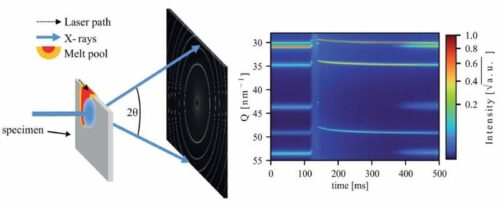Researchers have developed a way to unlock a computational tool for 3D-printing enabling more control over printed parts.

While the printing process wastes less material and can be used to produce more complicated shapes than traditional manufacturing methods, researchers have struggled to grasp how to steer metal toward particular kinds of crystals over others. This lack of knowledge has led to less than desirable results, such as parts with complex shapes cracking prematurely thanks to their crystal structure. But a new breakthrough could grant an unprecedented level of mastery over metal 3D printing.
Researchers at the National Institute of Standards and Technology (NIST), KTH Royal Institute of Technology in Sweden and other institutions, using two different particle accelerator facilities, have peered into the internal structure of steel as it was melted and then solidified during 3D printing. This unlocks a computational tool for 3D-printing professionals, offering them a greater ability to predict and control the characteristics of printed parts, potentially improving the technology’s consistency and feasibility for large-scale manufacturing.
To capture the high-speed phenomenon, researchers employed powerful X-rays generated by cyclic particle accelerators, called synchrotrons, at Argonne National Laboratory’s Advanced Photon Source and the Paul Scherrer Institute’s Swiss Light Source. The team sought to learn how the cooling rates of metal, which can be controlled by laser power and movement settings, influence crystal structure. Then the researchers would compare the data to the predictions of a widely used computational model developed in the 1980s that describes the solidification of alloys.
Within the synchrotrons, the authors set up additive manufacturing conditions for hot-work tool steel—a kind of metal used to make, as the name suggests, tools that can withstand high temperatures. As lasers liquified the metal and different crystals emerged, X-ray beams probed the samples with enough energy and speed to produce images of the fleeting process.
The data collected by researchers depicted the push and pull between two kinds of crystal structures, austenite and delta ferrite, the latter being associated with cracking in printed parts. As cooling rates surpassed 1.5 million kelvins (2.7 million degrees Fahrenheit) per second, austenite began to dominate its rival. This critical threshold lined up with what the model foretold.
The results indicate what cooling rates to select for the early solidification steps of the printing process. That way the optimal crystal structure would appear within their desired material, making metal 3D printing less of a roll of the dice. The model has long been a reliable tool for materials design in traditional manufacturing, and now the 3D-printing space may be afforded the same support.
Reference : Hans-Henrik König et al, Solidification modes during additive manufacturing of steel revealed by high-speed X-ray diffraction, Acta Materialia (2023). DOI: 10.1016/j.actamat.2023.118713






